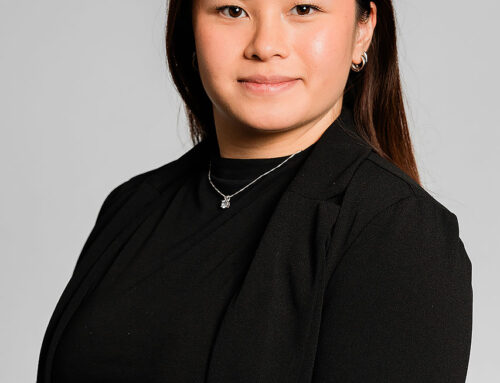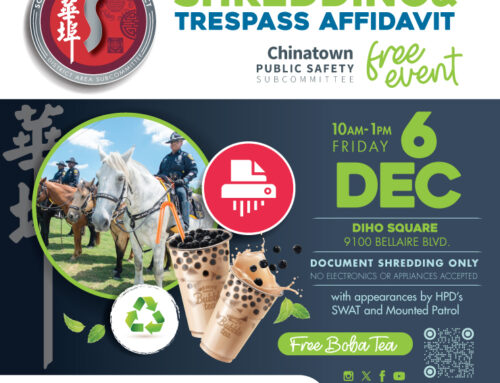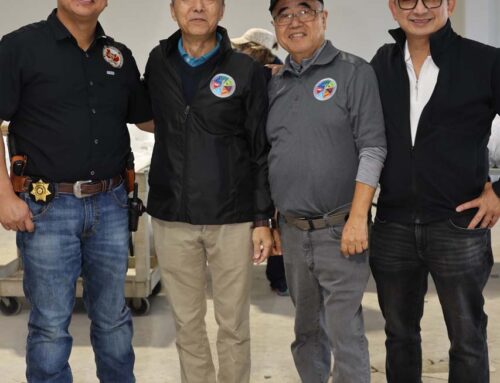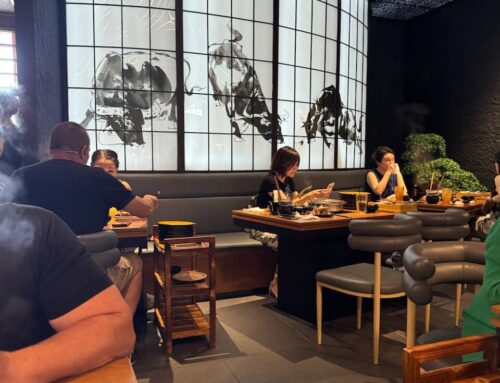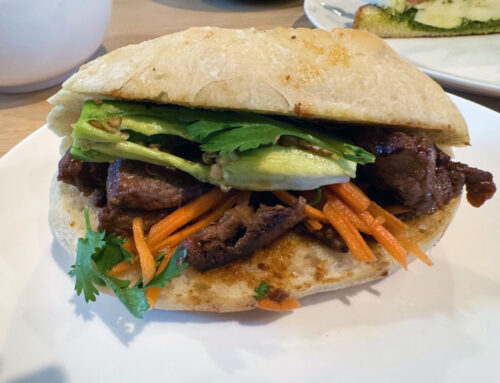
Shian Lian of Kamalan Bakery in Houston, Friday, February 12, 2021 (Photo by Michael Stravato)
Not too early. Not too late. At the Kamalan Bakery at 9889 Bellaire Boulevard, owner Shiann Lian always starts the first batch at 8 a.m. — two hours before opening. Any later, and customers won’t see the whole range of treats he creates. Any earlier, and they can’t savor the full joy of new bread.
“We want people walking right in to that fresh, hot-bread smell,” he said.
This winter, after an arid, disconnected year, I’ve found surprising joy in Asian bakeries in the Southwest Management District. For months I’ve been living mostly in only two dimensions. Walking into these shops, with their kindly fragrance and inventive wares, reminds me of what I miss the most about this city.
And each bakery, I’ve discovered, tells a story about the ways history, conquest and entrepreneurship flavor foods that I love. When I choose the day’s indulgences, I think about the generations of events that led to their particular mix of ingredients. I think of the persistent bakery owners battling through adversity now. And I wonder at the way, over the very long term, one of the tangible results of hardship can be something universally soothing.
Tucked into Dun Huang Plaza near Beltway 8, Kamalan was first opened by Lian and his wife Amy after they arrived from Taiwan 25 years ago. (He does the breads; she makes the cakes.) The couple had owned bakeries back home. Nevertheless, Lian enrolled in two years of culinary school here to add American technique to his repertoire.
Openness to foreign cultures: Good for business

And some, like the plain blocks labeled “pineapple cake,” blend both worlds, sublimely. Within each of these crisp shortcake cubes is an explosion of tart pineapple jam, which Lian boils for nine hours to perfect. The recipe, though, has been in the making for centuries, stirred by worldwide forces and events. According to writer Matthew Fulco, pineapple growing first became a Taiwanese economic mainstay under Japanese colonization, from 1895-1945. It was temporarily replaced by grain–growing in World War II, then dimmed again in the 1970s when Taiwan industrialized and neighbors with lower wages became the region’s pineapple powers. Taiwanese chefs created the pineapple cake to use up surplus local fruit.
Now these humble-looking squares are a Taiwanese signature – and they are essential giving during the two-week Lunar New Year, which started Feb. 12.
Western-style baked goods, overall, are a fairly late addition to this holiday, the highlight of the year in many Asian cultures.
“Lunar New Year is the most important holiday for Chinese. It marks the start of spring, so it’s a holiday about hope and prosperity,” Rice Business professor Yan Zhang told me. “People take a long time off — two weeks, after which there’s another holiday, the lantern festival — to relax, spend time with family and friends, and eat. And I have to say that baking is a new thing in China. Traditionally, people there steamed or fried foods made of wheat powder or rice powder.”
Sweet adaptations to hardship
Irresistible as they are, in other words, the treats at Houston’s Asian bakeries are sweet adaptations to hardship. Oven-baked wheat bread, for example, first appeared in Asia with 17th CenturyPortuguese traders in Japan. Over later centuries, as Japan imposed its influence throughout Asia, local communities reinterpreted its bread recipes for themselves. Today, East Asian cultures happily swap, scout and copy baking techniques by the hour, not the year.
“Taiwanese bakers have hit a sweet spot,” Taiwanese-American lifestyle blogger Leslie Yeh said, “taking the best of Japanese-style breads and combining them with whatever flavors are trending.” Their huge variety, she told me, is very Taiwanese: It reads as abundance.
Not that Asian bakeries are just about bread. Right next door to Kamalan, the Taiwanese Jungle Bakery Cafe is an austere shrine to nothing but fabulous desserts. Inside a chilly glass case, cakes erupt with fondant flowers, 3D seascapes and the face of a blissed-out Hello Kitty. In a separate case sit jewel-like pastries: a shiny pink bauble filled with coconut cake, a coffee mousse cushion perched on a brownie, and an all-white column of creamy vanilla cake wrapped in white chocolate mousse.
Still another type of Asian bakery anchors the strip mall across the street. At the Vietnamese-French Parisian Bakery Café, the chalkboard and wood fixtures have the cozy feel of a bistro, even if not one person was nibbling baguettes at its tables during a recent moment. The cases are crowded with enormous chocolate and almond croissants, along with some truly unforgettable cream puffs: fat, turban-shaped and filled with pastry cream so silken it’s like taking a cool drink. Even this monument to French culture, though, has an Asian soul. Side by side on the chalkboard with the French breads are iced coffee swirled with condensed milk, spring rolls full of brawny shrimp and hand-tied banana leaf parcels of sticky rice.
Like fellow Asian bakeries, in other words, Parisian Bakery Café is a living catalog of personal and national histories. Long before the 17th-century arrival of French missionaries, food writer Emily Monaco notes, Vietnamese were already influenced by tastes and techniques from neighboring countries, especially China. Later, during more than 70 years of French colonialism, they encountered ingredients such as butter and wine. But instead of adopting the outsiders’ customs wholesale, Vietnamese cooks folded them into their own, along the way inventing a cuisine appealing enough to sustain bakeries and restaurants, generations later, in far-off Houston.
Today, they’re part of a local food landscape so rich that Kamalan Bakery and its neighbor, chain bakery 85 C, inspired a plot point in Houston writer Jennifer Yen’s new novel, A Taste For Love. The businesses were models for the rivalrous bakers in her book, she told the Houston Chronicle.
But 2020 devastated Asian-run business through the city.
In the months before COVID prompted citywide shutdowns, Asian small business owners were already brutalized by rumors, violence, threats and diatribes about “the China virus.”
There’s something about bread
Only after months of struggle, some businesses are doing better, Lian said. He showed me a baking sheet filled with plastic signs he’d pulled from his emptied-out shelves. “Now, by late afternoon,” he said, “we’re almost sold out.”
Lian estimates that about 70 percent of his clients have Taiwanese, Chinese, Vietnamese, Korean or Japanese roots.
For many customers with Asian roots, bakeries like Lian’s have been havens of comfort for years.
“These mom-and-pop shops are exposing people to different foods, but they are also so important to the community,” Leslie Yeh, the Taiwanese-American food writer, told me. “A lot of children of immigrants went through childhood feeling, ‘There’s a food that I eat at home, and a food I eat in public.’ There was a sense of foreignness that you had to cover up.”
Coming from the suburbs and visiting Asian bakeries made her feel at home, she said. Now she loves seeing non-Asians lining up at the same places.
“Bread is a very easy way in to a cuisine,” she said. “You don’t have to over-explain it.”
I think she’s right. For a non-Asian like me, who moved to Houston decades ago, nibbling through a bag of pineapple bread and cupcakes from Kamalan in my living room is now a way to reclaim the city I fell in love with. For adventurous kids longing to horse around with their peers and sick of living onscreen, the same bag of snacks can launch a raucous, tasting party on Zoom — as my teenagers recently had with friends scattered throughout the city.
Something about newly baked bread seems to lift people’s spirits, Lian told me.
“My wife and I love this job,” he said. “And we’re always hearing it from customers in the bakery: ‘You have very, very good bread.’ They just seem happy to be here.” I feel that way too. So I keep going back, and I keep bringing treats home to share. As a Houstonian, I need the city’s Asian bakeries — their daily treasures, their history and their creativity in hard times — to flourish.
— By Claudia Kolker, editor of the ideas magazine at Rice Business School, and author of “The Immigrant Advantage: What We Can Learn From Newcomers To America About Health, Happiness And Hope.”
— Photos by Michael Stravato
This article is adapted from an essay that appeared in the Houston Chronicle.




